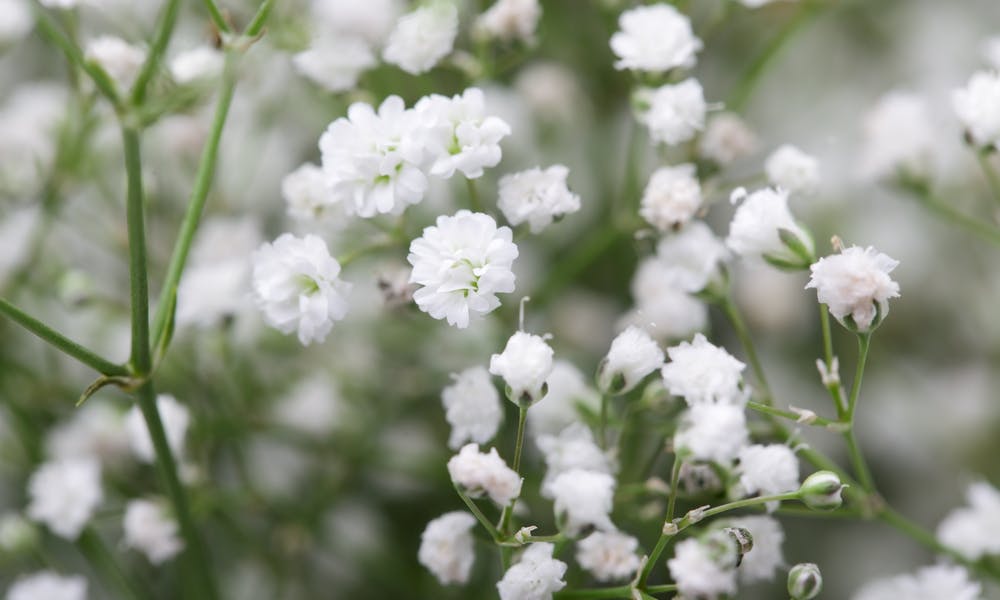MENU
Baby’s Breath Flower

One of the most widely used ornamental flowers in the world, the baby’s breath flowers beauty has been gracing the bouquets and homes of people around the world for many years. A handy plant to have around, it can be used in a variety of areas in life from photography to soap to cancer treatment. We explore its history in the world, fun facts and all there is to know in this article.
Keep reading to find out the:
- History of the Baby’s Breath Flower
- Flower Specs
- Meaning and Symbolism
- Color Symbolism
- Medicinal Facts
- Use in Cuisine
- Fun Facts
- Planting Tips
- How to Care for the Flower
History of the Baby’s Breath Flower
Known scientifically as the gypsophila, the baby’s breath flower is a flowering plant that is part of the carnation family, caryophyllaceae. They are a native genus to parts of Australia, Eurasia, the pacific islands, as well as regions of Africa. There are close to 150 species within the genus. Most are perennial plants, although some annuals exist, and they grow particularly well in thick, loamy soil that is known as gypsum.
Flower Specs
As one of the largest groups of flowers in the carnation family, they can be predominantly found on the mountain steppes of Eurasia. There are a wide variety of flower shapes, known as inflorescence, with some being lax thyrses or panicles, others being cymes, as well as some raceme-like monocashia. The tiny blossoms have a calyx that is somewhat cup-shaped, with sepals made up of five petals. They contain fruit that is capsule-shaped, with many seeds that look like small kidneys. The plants can grow almost as tall as 2 meters and anywhere from 30-50 cm in width. They are found in shades of pink, white, yellow, blue, as well as red.
Meaning and Symbolism
The name gypsophila stems from the flowers thriving in gypsum soil. The baby’s breath is a common ornamental flower placed within wedding bouquets and centerpieces and has become strongly associated with feelings of love and affection. Its white petals are associated with the purity of marriage, as well as the innocence of children, and are given as gifts to expecting mothers. Many people associate the flowers with devotion to a relationship, whether family, friends, or lovers. Within Christianity, it is thought to symbolize the strength of the Holy Spirit.
Color Symbolism
Baby’s breath flowers come in a variety of colors, each with deep significance. The white variety is associated with unity and spirituality. The blue is thought to relate to honesty, as well as respect. Orange relates to feelings of positivity and joy, while the red is a symbol of love and passionate romance. The pink variety stands for a gentle spirit, while purple is thought to be connected to nobility and beauty.
Medicinal Facts
The baby’s breath flower is very well-known for its possible anti-cancer fighting properties. Chemicals within the flower known as saponins have the ability to break down cancer cells, opening them up to being killed by anti-cancer drugs by up to a million-fold. There is some research showing it could be useful as a spermicide. The saponins, though useful in medicine, can provoke allergic reactions in some people, so be sure to use gloves or wear a mask if you think you are susceptible.
Use in Cuisine
Some species of baby’s breath are edible, with the roots and other parts of the baby’s breath flower being used in numerous cuisines. Extracts from the flower can be found in products such as herbal cheese, ice cream, and liqueur. They are used in sweet halva, which is a very popular dessert made in the Middle East, as well as parts of Asia.
Fun Facts
The baby’s breath flower has some pretty cool uses in the world. They are commonly planted in boron-rich soil to absorb the mineral, as it can be quite poisonous to the soil in large quantities. Due to their high saponin content, the plant can be used for a variety of purposes. It can be found in the production of photographic film, and as reagents in hemolytic laboratories. They also have useful detergent properties and are used in many soaps, as well as shampoos. Many people grow their own to sell to florists, and other companies using the extracts for commercial use.
Planting Tips
Baby’s breath can be started from cuttings or transplanted from a nursery. Seeds can be used as well, although it can take quite a while before you get your first blooms. If you choose seeds, spread them in a starting tray covered in a thin layer of organic matter and soil. Mist lightly. Keep them in a warm location for germination. Once you transplant, pick an area that receives full sun. The plants require well-drained soil to thrive, with a slightly acidic ph. of 7.0 or so. Adding a good amount of organic matter, such as manure or peat moss helps them grow quite well.
How to Care for the Flower
The baby’s breath flower does not require too much care to stay healthy. Applying small amounts of fertilizer during the blooming season is recommended, but the plant requires very little water or fertilizer overall. If they become too top-heavy at any point, pruning is recommended. Be careful with shifting any of the roots because they are very fragile. Make sure to space them out well to reduce the risk of mildew and mold. The plants require lots of air circulation to stay healthy.
The Lovely Baby’s Breath
From its slim, delicate stems to its beautiful flower petals, the baby’s breath flower is a wonderful sight to behold. It has been famous since Victorian times for a reason and can be a great addition to any household or office. For those looking to have a beautiful flower on hand for gifting to loved ones, look no further!

